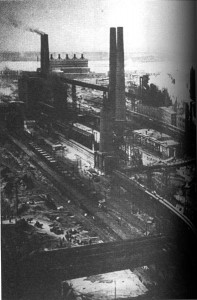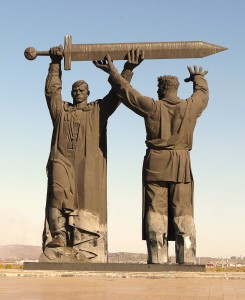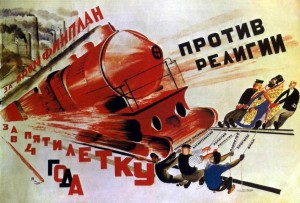The Soviet Union during its lifetime was made up of a multitude of peoples and cultures. Not only did it consist of Russians but Ukrainians, Georgians, the numerous peoples of the Caucus, the Kazakhs, Chechens and peoples of the Eastern Steppes among others. Among these people were innumerable minorities with differing languages and cultures. A real challenge for the Soviet Union of the 1920s was how to reach these diverse peoples with the message of the revolution. Furthermore, how was the Soviet government supposed to classify the numerous minorities that made up its work force. The consensus it seemed was to look to language to be the classifier of the people.
To the Soviet bureaucracy, the idea of nationality and cultural identity was a very important part of the uniformity of the communism idea. These identities were encouraged to foster in order to break out from under the thumb of Russian chauvinism. Ethnic peoples were encouraged see themselves as as the nationality of their birth instead of being members of the Russian empire.[1] a distinction to make is that these peoples were encouraged to become Soviet States, not whole separate nationality’s.[2] It was the hope of the Soviet government that this ability to develop a different and unique culture, as well as the encouragement to function in the native language would help propel the backwards parts of the Union onto the level of the government operating out of Russia. To reach the population of the minority’s, there would be “national languages” “national cultures” and “national cadres”[3] What this would create, was a feeling of uniformity and national identity as all peoples, no matter the class or ethnicity, would be given similar or the same perspective on communist scholarship.
Especially important was the teaching of said scholarship and ideas in the language of the native peoples. The theory was that if they (the workers) were instructed in words they could understand the highest efficiency would be brought out of them. Unfortunatly this would have side effects that would result in minority’s being forced to learn languages or to be intergrated in cultures based on there ethnicity. These languages would be standardized as official languages. “All languages identified during the 1920s…would become official.”[4] Soon language newspapers and propaganda would help foster a soviet identity that would help spread the communist message around the Union.
[1] Yuri, Slezkine “The Soviet Union as a Communal Apartment,” Slavic Review 53, no. 2 (1994): 423.
[2] Yuri, Slezkine “The Soviet Union as a Communal Apartment,” Slavic Review 53, no. 2 (1994): 423
[3] Yuri, Slezkine “The Soviet Union as a Communal Apartment,” Slavic Review 53, no. 2 (1994): 422
[4] Yuri, Slezkine “The Soviet Union as a Communal Apartment,” Slavic Review 53, no. 2 (1994): 430



